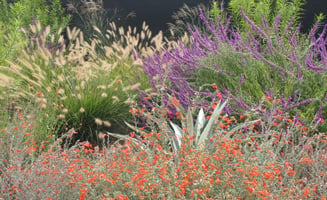

Contributor
- Topics: Archive

Gardening is so very local. But these days we’re all factoring in how much water our gardens require. Making the most of this precious resource when planning and planting involves many strategies: building good soil, applying mulch, and maybe even installing a water catchment system. But perhaps the best place to begin is to get to know your specific region and then select plants according to the amount of water you have, or want to invest in your landscape.

Providing just enough water—neither too much nor too little— saves money, avoids waste, and promotes plant health. That lovely perennial (grass, bulb, tree, or shrub) requires differing amounts of irrigation to thrive depending on where you live. This makes perfect sense when you consider the difference between conditions in California’s hot arid Central Valley compared to the cool summers and relatively higher humidity of coastal regions. But you won’t find this sort of regionally specific water use information on plant labels—or even in most gardening books.


That’s when California gardeners can turn to WUCOLS IV (WUCOLS stands for Water Use Classification of Landscape Species). The online database classifies and provides regional variables for more than 3,500 commonly available landscape plants.
So before you begin your next planting project, take a moment to explore WUCOLS IV.
Share:
Social Media
Garden Futurist Podcast
Most Popular
Videos
Topics
Related Posts

Low Maintenance Gardens – Better for Pollinators and People
Autumn 2022 “I come out every day. It’s therapy, my meditation.” Janet’s young garden transformed from overgrown, invasive plants to mostly natives. The dailiness of

Calochortophilia: A Californian’s Love Affair with a Genus
Summer 2022 I can chart the progression of my life by Calochortus. For the last two decades, at least. As a teenage girl growing up

Pacific Plant People: Carol Bornstein
Spring 2022 Public gardens play a key role in demonstrating naturalistic planting design, selecting native and adapted plants for habitat, and testing techniques for reducing

Add Year-Round Interest and Winter Blooms for Pollinators
Spring 2022 This article was created from an Interview by Merrill Jensen with Neil Bell in the Summer of 2021 for our Pacific Plant People










Responses